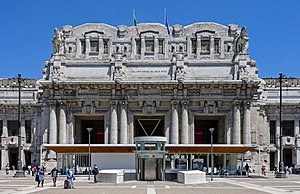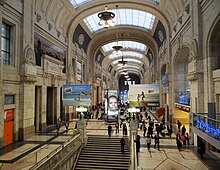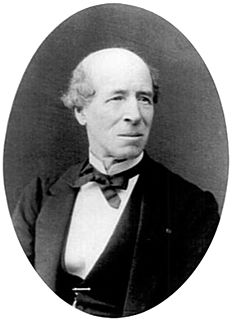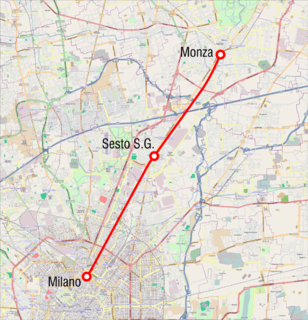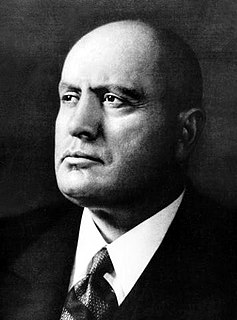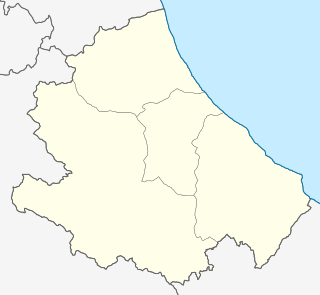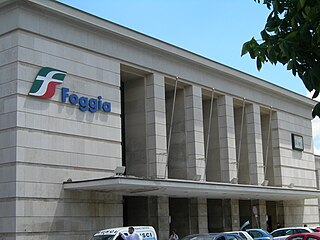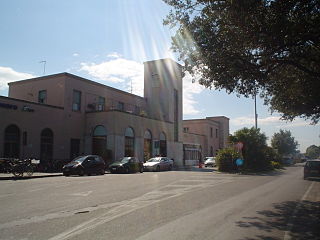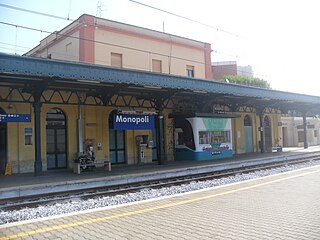It has been requested that the title of this article be changed to Milano Centrale railway station. Please see the relevant discussion on the discussion page. Do not move the page until the discussion has reached consensus for the change and is closed. |
Milano Centrale | |
|---|---|
Main entrance portico on Piazza Duca d'Aosta, 2016 | |
| Location | Piazza Duca d'Aosta 20124 Milan Italy |
| Coordinates | 45°29′10″N09°12′13″E / 45.48611°N 9.20361°E Coordinates: 45°29′10″N09°12′13″E / 45.48611°N 9.20361°E |
| Owned by | Rete Ferroviaria Italiana |
| Operated by | Grandi Stazioni |
| Line(s) | |
| Tracks | 24 |
| Connections |
|
| Construction | |
| Architect | Ulisse Stacchini |
| History | |
| Opened | 1 July 1931 |
| Electrified | 1938 |
| Traffic | |
| Passengers | 120 million per year |
| Location | |
Milan Central or Milano Centrale (Italian : Stazione Milano Centrale) is the main railway station of the city of Milan, Italy and is the largest train station in Europe by volume. The station is a terminus and located at the northern end of central Milan. It was officially inaugurated in 1931 to replace the old central station (built 1864), which was a transit station but with a limited number of tracks and space, so could not handle the increased traffic caused by the opening of the Simplon tunnel in 1906.

Italian is a Romance language of the Indo-European language family. Italian, together with Sardinian, is by most measures the closest language to Vulgar Latin of the Romance languages. Italian is an official language in Italy, Switzerland, San Marino and Vatican City. It has an official minority status in western Istria. It formerly had official status in Albania, Malta, Monaco, Montenegro (Kotor) and Greece, and is generally understood in Corsica and Savoie. It also used to be an official language in the former Italian East Africa and Italian North Africa, where it plays a significant role in various sectors. Italian is also spoken by large expatriate communities in the Americas and Australia. In spite of not existing any Italian community in their respective national territories and of not being spoken at any level, Italian is included de jure, but not de facto, between the recognized minority languages of Bosnia-Herzegovina and Romania. Many speakers of Italian are native bilinguals of both standardized Italian and other regional languages.

Milan is a city in northern Italy, capital of Lombardy, and the second-most populous city in Italy after Rome, with the city proper having a population of 1,372,810 while its metropolitan city has a population of 3,245,308. Its continuously built-up urban area has a population estimated to be about 5,270,000 over 1,891 square kilometres. The wider Milan metropolitan area, known as Greater Milan, is a polycentric metropolitan region that extends over central Lombardy and eastern Piedmont and which counts an estimated total population of 7.5 million, making it by far the largest metropolitan area in Italy and the 54th largest in the world. Milan served as capital of the Western Roman Empire from 286 to 402 and the Duchy of Milan during the medieval period and early modern age.

Italy, officially the Italian Republic, is a country in Southern Europe. Located in the middle of the Mediterranean Sea, Italy shares open land borders with France, Switzerland, Austria, Slovenia and the enclaved microstates San Marino and Vatican City, as well as a maritime border with Croatia. Italy covers an area of 301,340 km2 (116,350 sq mi) and has a largely temperate seasonal and Mediterranean climate. With around 61 million inhabitants, it is the fourth-most populous EU member state and the most populous country in Southern Europe.
Contents
- History
- Train services
- Domestic (High-speed)
- Domestic
- Cross-border (Night train)
- Cross-border
- Platforms
- Unusual track layout
- Gallery
- See also
- References
- External links
Milano Centrale has high speed connections to Turin in the west, Venice via Verona in the east and on the north-south mainline to Bologna, Rome, Naples and Salerno. The Simplon and Gotthard railway lines connect Milano Centrale to Bern and Geneva via Domodossola and Zürich via Chiasso in Switzerland.

High-speed rail in Italy consists of two lines connecting most of the country's major cities. The first line connects Turin to Salerno via Milan, Bologna, Florence, Rome and Naples, the second runs from Turin to Venice via Milan, and is under construction in parts. Trains are operated with a top speed of 300 km/h (190 mph).

The Turin–Milan high-speed railway line is a link in the Italian high-speed rail network. It is part of Corridor 5 of the European Union's Trans-European high-speed rail network, which connects Lisbon and Kiev. The section between Turin and Novara opened on 10 February 2006, while the remainder opened on 5 December 2009.
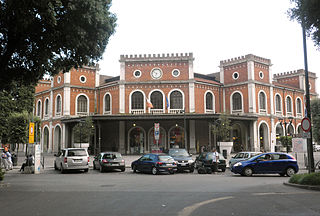
The Milan–Venice railway line is one of the most important railway lines in Italy. It connects the major city of Milan, in Lombardy, with the Adriatic Sea at Venice, in Veneto. The line is state-owned and operated by the state rail infrastructure company, Rete Ferroviaria Italiana that classifies it as a trunk line. The line is electrified at 3,000 volts DC.
Destinations of inter-city and regional railways radiate from Milano Centrale to Ventimiglia (border of France), Genova, Turin, Domodossola (border of Swiss Canton of Valais/Wallis), Tirano (border of Swiss Canton of Graubünden/Grisons), Bergamo, Verona, Mantova, Bologna and La Spezia.
The Milan suburban railway service, however, does not use Milano Centrale but the other mainline stations: Porta Garibaldi (northwest), Cadorna (west) and Rogoredo (east).

The Milan suburban railway service is a commuter rail system serving the metropolitan area of Milan, Italy. The system comprises 12 lines serving 125 stations, for a total length of 403 km. There are 415 trains per day with a daily ridership of about 230,000.
